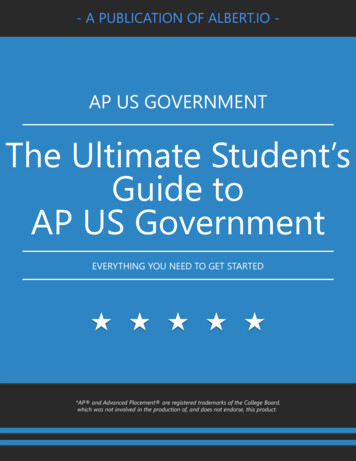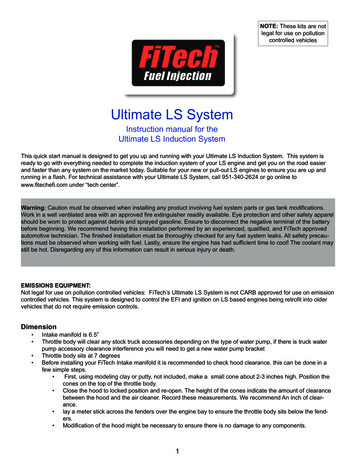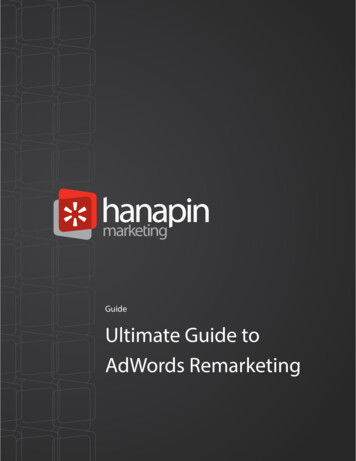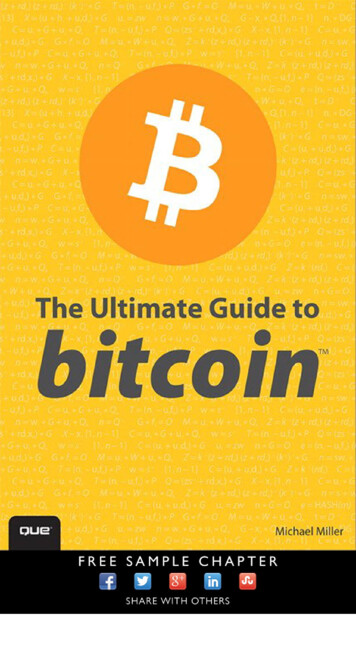
Transcription
- A PUBLICATION OF ALBERT.IO -AP US GOVERNMENTThe Ultimate Student’sGuide toAP US GovernmentEVERYTHING YOU NEED TO GET STARTED*AP and Advanced Placement are registered trademarks of the College Board,which was not involved in the production of, and does not endorse, this product.
Ready to get a 5?Stop stressing about the AP US Government exam.Albert has got your back!With thousands of practice questions, personalizedstatistics, and anytime, anywhere access, Albert helpsyou learn faster and master the difficult concepts youare bound to see on test day.Click below or visit www.albert.ioStart Practicing
TABLE OF CONTENTS6Introduction7About Us10Democracy Theories17Federalism24Constitution Review31Checks and Balances37Bureaucracy
TABLE OF CONTENTS44Iron Triangle50Linkage Institutions55Political Socialization62Super PACs69Electoral College751960 Election
TABLE OF CONTENTS811964 Election871972 Election941976 Election101Key Supreme CourtCases109How to Study forAP US Government130The Ultimate List ofAP US Government Tips
IntroductionThis eBook is meant to provide a short collection of important principles that areoften assessed on the AP US Government exam. Inside, you’ll find overviews ofcentral concepts and their relevance to the test, as well as study strategies andtips.It features information from the Albert Blog. If you’re looking for additional helpin preparing for the APs, be sure to regularly check the blog and subscribe to hearabout our new posts.E-mail us at hello@albert.io if you have any questions, suggestions, or comments!Last Updated: December 2016Interested in an Albert license? E-mail us at schools@albert.io6
About UsWhat is Albert?Albert bridges the gap between learning and mastery with interactive contentwritten by world-class educators.We offer: Tens of thousands of AP-style practice questions in all the major APs A complete competitive online leaderboard to see where you standcompared to others Immediate feedback on each question answered An easy to access platform from any Internet-enabled device In-depth personal statistics to track your progress Intuitive classroom tools for teachers and administratorsInterested in an Albert license? E-mail us at schools@albert.io7
Why Educators Love UsWe asked teachers how their students did after using Albert.Here is what they had to say:My students had an 81.2% passing rate - the previous year was 76%(the highest rate in our county)! I am thrilled. I had 64 students total,with 6 receiving 5s, 19 scoring 4s, 27 receiving 3s, 10 scored 2s and 2received 1s.Susan M., JP Taravella High70% of my students scored 3 or higher. This is up from last year, and isalso well above the national average. Needless to say, I am veryhappy with my students' success. I used Albert more intentionally thisyear. In the beginning of the year, I wanted students simply to answerquestions and practice. Once they had 150-200 questions answered,we looked for trends, strengths, and weaknesses and worked onaddressing them. Students were tasked with increasing their answeraccuracy no matter how many questions it took, then they set theirown goals (some wanted to focus around tone; others neededpractice with meaning as a whole).Bill S., Lapeer High SchoolLast year 40% passed with 3s and 4s. This year 87% passed, most had4s and 5s. We used the stimulus-based multiple choice questionsthroughout the year and as review for the exam. I think it helpedtremendously.Alice P., First Baptist Christian AcademyInterested in an Albert license? E-mail us at schools@albert.io8
Why Students Love UsWe asked students how they did after using Albert.Here is what they had to say:I scored very well this year – four 5s and one 4. Albert helped me getused to the types of questions asked on the exam and overall myscores were better this year.Robyn G., Chambersburg Area Senior High SchoolLast year was my first year taking an AP test, and unfortunately I didnot do as well as I had hoped. The subject had not been my best, andthat was definitely displayed on my performance. However this year, Imade a much higher score on my AP test. The previous year had beenAP World History and I had made a 2. For this year it was AP EnglishLanguage, and I scored a 4. There was a definite jump in my score,because Albert pushed me to focus on my weaknesses and form theminto strengths.Charlotte R., Rome HighI scored a 4 on AP Biology, much higher than expected. Albert was aneffective resource to guide me through AP Biology. Keeping up with itconsistently all year as I learned the lesson in class was crucial toreinforcing my understanding and long-term memorization of Biology.After class each day, Albert helped to sink in the ideas that I wastaught in the morning.Lily O., Wake Forest High SchoolInterested in an Albert license? E-mail us at schools@albert.io9
Democracy Theories:AP US GovernmentCrash CourseImage Source: Wikimedia CommonsWhat Do I Need to Know About the Theories of Democracy to Prep forthe AP US Gov Exam?If you are preparing for the AP US Government exam, you need to be ready towrite and answer questions about the various democracy theories that politicalscientists have identified. The CollegeBoard considers it such an important topicthat they feature a question about the Theories of Democracy in the AP US Govcourse description.Interested in an Albert license? E-mail us at schools@albert.io10
Democracy Theories:AP US Government Crash Course Cont.What is Democracy?Democracy was first practiced by the ancient Greeks, who believed that thepeople should have a voice in their governance. Aristotle, philosopher and authorof a comparison of the different forms of government called Politics, warned thatdemocracy, or the rule of the people, was a good thing that could be easilycorrupted. This idea will be re-visited later in the article! In the meantime, knowthat from Greece, and later Rome, the United States has adopted manydemocratic ideas, which makes Theories of Democracy one of the key AP US Govconcepts for you to review.One of the essential questions that is asked in any society is “Who governs?” Toanswer this question, you have to ask yourself who is making the laws, who hasinfluence over public policy, who will be the next president, congressman, orsenator? If you answered, “the people”, you are halfway there! But wait! Just howdo “the people” make their voices heard in a democracy? Keep reading to findout.Direct DemocracyIn a direct democracy, the people’s voices are heard when citizens vote on actualdecisions and bills. This was the type of democracy used in ancient Greece. In adirect democracy, a citizen would consider his or her opinion on a potential law orleader. Then, he or she would cast a vote and the votes would be counted toarrive at a majority decision.Direct democracy is rare. It is much more likely to be seen in a small nation withfew people allowed to vote. Think about how difficult it would be for a largenation like the United States to have over two million people casting votes onevery decision. It would be cumbersome, expensive, and even if it could be doneonline, would be difficult to monitor.Interested in an Albert license? E-mail us at schools@albert.io11
Democracy Theories:AP US Government Crash Course Cont.Another reason why direct democracy is hard for societies to actually implementis that few citizens have the time, energy, or interest in informing themselves onevery issue. The type of issues that excite people’s interest enough to cause themto form an opinion (think gun control, speed limits, abortion) are calledmajoritarian issues. Most issues, however, are not majoritarian issues and onlythose affected by the potential law are very informed about it.Who really cares about the issues enough to devote their time and effort tounderstanding them? In an indirect democracy, the answer is electedrepresentatives.Indirect DemocracyIn an indirect democracy, the citizens elect a representative who will cast votesand make decisions on their behalf. Through the citizens’ representatives, they arestill able to make their voice heard in the government, but they don’t need toinform themselves on every issue, and may pursue other interests, entrustingtheir elected representatives to make the decisions that represent their desires.Rather than vote on individual issues and bills, citizens in an indirect democracychoose from a number of candidates, voting for a representative. This is whyindirect democracy is also called representative democracy, or republicandemocracy.Note: Don’t get confused! When the words democratic or republican are used inthe lower case and in the context of Theories of Democracy, they do not refer topolitical parties! Instead, democratic government emphasizes the voice of thepeople and republican government emphasizes representation.Interested in an Albert license? E-mail us at schools@albert.io12
Democracy Theories:AP US Government Crash Course Cont.Which of the Democracy Theories did the Founders Choose?Which type of democracy does the United States have, a direct democracy or anindirect one? Perhaps the best way to answer the question is that the UnitedStates is a “democracy in a republic”. That means that the people DO have a voicein government, but rather than expressing that voice directly, they arerepresented by a legislator.Remember Aristotle’s concern about corruption? In many ways, the framers of theAmerican democracy felt that democracy could be dangerous. This is why, ratherthan implementing a direct democracy, the founding fathers took the decisionsout of the people’s hands directly and created a system in which the people wouldvote for an elected representative. In other words, they chose indirect democracyover direct democracy.Do any Direct Democracies Exist? How can I give an Example of One?Very few examples of direct, or pure democracy can be found. However, for yourAP US Gov review, you should be able to point to one or two examples of directdemocracy. Review the bullets below and make sure you can explain how they areexamples of direct, rather than indirect, democracy: Government in ancient Greece, perhaps the only true democracy inhistory. As Greece grew larger, however, and allowed more than just itsmost privileged citizens to vote, direct democracy could not last. There isno example of direct democracy in a modern nation state. However The government of Switzerland comes closest to a modern day exampleof direct democracy. In Switzerland, many of the decisions at the Canton(state) level are put directly to the people. Another good example of direct democracy is the New England TownMeeting. When the colonies were just beginning, some colonialgovernments were governed by allowing the people to vote directly onthe issues facing the colony. Examples of this were found inMassachusetts and Connecticut.Interested in an Albert license? E-mail us at schools@albert.io13
Democracy Theories:AP US Government Crash Course Cont.What About Examples of Indirect Democracy?The best example of an indirect democracy for you to use on your AP USGovernment exam is the United States! It is important that the graders know thatyou are aware that the United States is an indirect, representative, or republicandemocracy. Using these terms interchangeably throughout your essay will helpthe graders to know that you understand this.Other examples of indirect democracies are Germany, India, Great Britain, andTaiwan. Remember, a democracy does not just mean a country with a President. Acountry with a king or queen can also have “rule by the many”, which is whatdemocracy means!Now, on to the last point of our review of this important AP US Governmentconcept How do Representatives Function in an Indirect Democracy?In a representative democracy (remember to use these words interchangeably!),how do the people chosen to represent the “rule of many” know what the peoplereally think? Since the people do not directly vote on the issues as in a directdemocracy, the representatives must have some basis on which to act. Politicalscientists cite two models that characterize the people’s representatives: thetrustee model and the delegate model.In the trustee model, representatives are elected by the people after the voterscarefully consider their merits as leaders and thinkers. Therefore, in the trusteemodel, legislators should follow their own conscience and judgment when castingvotes. Think of it this way: The democratic aspect is still present in the trusteemodel, it just takes place in the people’s voices being heard before and not duringthe actual voting process.Interested in an Albert license? E-mail us at schools@albert.io14
Democracy Theories:AP US Government Crash Course Cont.Some disagree with the trustee model, following instead a delegate model ofrepresentation. In the delegate model, the representative serves more literally asa delegate or agent of the citizens. Those who believe in the delegate model placeemphasis on polling their constituents and would claim that their conscience doesnot matter because they are bound to vote as the people in their district would.What Should I Expect on the Actual AP US Gov Exam?If you have not seen a sample exam, use links to AP Central to view a sample testin the course description or to see the format of past essay questions. The AP USGov exam requires you to answer four FRE (Free Response Essays). Unlike some ofthe other AP social studies exams, the AP US Gov exam seeks responses that areless essay driven and more of a point by point answer to multiple and relatedquestions.On the AP US Government exam, you are almost sure to have a question thatinvolves AP US Gov concepts such as Theories of Democracy. Lets look at theexample provided in the AP US Gov Course Description:a. Define direct democracy.b. Define republican form of government.c. Describe one reason the framers of the United States Constitution chosea republican form of government over a democracy.d. Describe each of the models of Congressional representation. Trustee model (attitudinal view) Delegate Model (representational view)e. Explain why a member of Congress might sometimes act as a trusteerather than a delegate.Interested in an Albert license? E-mail us at schools@albert.io15
Democracy Theories:AP US Government Crash Course Cont.Check Yourself! Ready for Questions on the Theories of Democracy onthe AP US Gov Exam?To gauge whether or not you’re ready to be tested on the following AP Govconcepts, ask yourself the following: What is a democracy (Who governs?)What is the difference between direct and indirect democracy?What are some synonyms for and examples of direct democracy?What are some synonyms for and examples of indirect democracy?Interested in an Albert license? E-mail us at schools@albert.io16
Federalism:AP US GovernmentCrash CourseImage Source: FlickrFederalism is a unique idea, particular to American government. So, when youtake the AP US Government & Politics exam, you are going to be asked a lot ofquestions about what federalism is and how it works.Interested in an Albert license? E-mail us at schools@albert.io17
Federalism:AP US Government Crash Course Cont.Types of Government PowerDon’t be overwhelmed. The framework of the federal system is actually prettysimple. Under federalism, the national—or federal—government has certainpowers and the states have other powers.Let’s look at the various types of power, and what level of government wieldsthem.Federal powers, consisting of1. Delegated powers: also called express powers, are written in theConstitution.2. Implied powers: can be reasonably inferred from the Constitution.3. Inherent powers: don’t rely on specific clauses of the Constitution butemanate from the nature of the federal government—for example, issuesrelating to foreign affairs.Reserved powers: These are powers that are neither given to the federalgovernment nor denied to the states. Although these powers are not expressed,they are guaranteed to the states via the 10thIn general these powers relate to states being able to govern their internalaffairs—e.g., have police and fire departments.Concurrent powers: These powers are held by the federal government and stategovernments, and include the powers of taxation and to make laws.Prohibited powers: These powers are denied to the federal government or stategovernments, or both. One example of a prohibited power is the taxing of exports.Interested in an Albert license? E-mail us at schools@albert.io18
Federalism:AP US Government Crash Course Cont.The Supremacy ClauseArticle VI of the Constitution, the Supremacy Clause, states that the Constitutionis the “supreme Law of the Land.” This means that all officials of the country,including state officials, must give oaths to support the Constitution, and statescannot override national powers.So, from the very beginning the states were viewed as somewhat secondary tothe federal government. Over time, states’ powers would increase, to the benefitof the federal government.Let’s look at how that process played out.Early Federalism—or Dual FederalismUp until the Civil War, the original interpretation of federalism was somethingknown as dual federalism. This view held that the Constitution had given limitedpowers to the federal government and left most powers in the hands of thestates.The federal government was held to dominate in its areas of influence (e.g.,foreign affairs) and the states in theirs (e.g., slavery or education), with theSupreme Court acting as umpire when disputes arose between the two.After the Civil WarDual federalism was criticized for not adequately protecting citizens from statesthat denied freedom (for example, slavery and Jim Crow laws) and for being illequipped to handle the social and economic changes affecting the country.Post-Civil War, federalism has evolved considerably. The causes of this include theCivil War, the territorial expansion of the U.S., America becoming an industrial andinternational power, the two World Wars and the perceived threats ofcommunism to American interests.Interested in an Albert license? E-mail us at schools@albert.io19
Federalism:AP US Government Crash Course Cont.After the Civil War, the biggest change to federalism was the application of federalrights—those contained in the Bill of Rights—to the states. Previously, the Bill ofRights applied only to the federal government; after it applied across-the-board.Cooperative FederalismAfter the Great Depression, cooperative federalism saw the federal governmentexpand its domestic activities. Under this idea, also known as fiscal federalism,the federal government sends monies to the states, and attaches stipulations, orrules and regulations, to the funds.This allows the federal government to exercise much more power over domesticaffairs than it was given in the Constitution.Both liberal and conservative presidents have utilized cooperative federalism toimplement their policies. Obamacare contains many instances of cooperativefederalism; so too did President Bush’s No Child Left Behind law.The idea of cooperative federalism views federalism as a system to help providegoods and services to citizens. Again, Obamacare is a good example of this, as thefederal law set up a framework for state governments to establish statewideexchanges that would provide affordable healthcare options to citizens.Essentially—the federal government gives the states money and tells them how tospend it. The states thus become agents of federal policy.Now let’s look at some elements of federalism within the federal government.The Separation of PowersInherent to the federal system is the separation of powers within the federalgovernment. This is Government 101. Congress passes legislation and thepresident signs it into law.Interested in an Albert license? E-mail us at schools@albert.io20
Federalism:AP US Government Crash Course Cont.If the president vetoes legislation, Congress can override the veto and pass thelegislation with the vote of two-thirds of each house.The Supreme Court can declare acts of Congress or actions by the presidentunconstitutional. A constitutional amendment is required to subvert this.Checks and BalancesThe veto power is part of the federal system of checks and balances – powersgiven to each branch of government to prevent unfettered action by the otherbranches.The Supreme Court’s power to rule acts unconstitutional falls within the systemalso of checks and balances. This power is known as judicial review.Another example of checks and balances is the requirement that the Senateapprove presidential nominees and treaties with other nations.Let’s look at the basic powers that the federal government and the states have.Basic Federal Powers1. Taxation2. Raise and maintain the army3. Declare war4. Regulate commerce5. Supreme Court rulings6. Rights incorporated by the 14th Amendment—in other words, theapplication of the Bill of Rights to the States7. Miscellaneous (laws against kidnapping, crossing state lines to commitcrimes, harming federal officials, violating civil rights)Interested in an Albert license? E-mail us at schools@albert.io21
Federalism:AP US Government Crash Course Cont.Basic State Powers1. Taxation2. Conducting elections3. 10th Amendment rights4. ‘Traditional’ rights such as marriage licenses, business licenses, criminallaws, educationNot too complicated, right? Now let’s take a look at a sample free-responsequestion.Federalism in the United States has shifted from a form known as “dualfederalism” to a newer “cooperative federalism.”1. Define these two kinds of federalism.2. Explain why this newer concept of “cooperative federalism” favors thepowers of the central government.Part (a) is easy to answer. Again, dual federalism was the view that the federalgovernment and state governments operated in separate spheres, and had fewpowers, aside from taxation, that overlapped. Cooperative federalism sees thetwo levels of government working in tandem on many issues, such as healthcareand education.Now, let’s think about (b). Why does cooperative federalism favor federal power?One word: money. Since the federal government gives its money to the stateswith strings attached, it can exercise considerable policy control via these strings.Federal highway funds, for example, are contingent on states keeping theirdrinking ages at 21—otherwise, no more money from Uncle Sam to build roads!Interested in an Albert license? E-mail us at schools@albert.io22
Federalism:AP US Government Crash Course Cont.OverallThis basic overview should serve you well as you prepare for the AP USGovernment & Politics exam. Remember, though—this is just an outline. You’llwant lots of specific examples of cooperative federalism in the event you’re askedto answer a federalism-based free-response question.Interested in an Albert license? E-mail us at schools@albert.io23
Constitution Review:AP US GovernmentCrash CourseImage Source: Public Domain FilesIt is arguably the most revered document in the world. Countless countries, afterrevolution or liberation, have looked to it to guide their own nation-buildingprocesses. The Constitution, written in the wake of the failed Articles ofConfederation and ratified by the states in 1789, outlines the structure andfunction of our government and also, through the Bill of Rights and subsequentamendments, guarantees our civil rights and liberties.Interested in an Albert license? E-mail us at schools@albert.io24
Constitution Review:AP US Government Crash Course Cont.Americans are proud of their Constitution and are highly reluctant to allow anychanges to it, which is why in our nation’s entire history it has only been amended27 times, and only after considerable struggle. Many worthy amendments—suchas the Equal Rights Amendment—have failed to pass because of this sentiment.The Constitution is only five pages long. It merely outlines the structure and basicfunctions of government; it was left up to Congress to create laws that wouldgovern the activities of quotidian life. The meaning of the Constitution, when it isunclear, is left up to the Supreme Court to decide. Over the years, the Court hassupplanted the Constitution with a wide body of constitutional law, which hasclarified and at times expanded Americans’ rights and liberties.The Constitution of 1787The Constitution contains seven articles. Most of the Constitution deals with thelegislature, or Congress (Article I). The founders considered Congress to be theprimary branch of the new government—as opposed to the presidency. Recordsof the Constitutional Convention show that most of the time was spent dealingwith Article I.The only real specifics contained in the Constitution—things like the Speaker ofthe House and the President of the Senate—pertain to the Congress. Congress isalso given 17 specific duties, such as regulating interstate commerce and creatingroads.The ExecutiveMost of the details about the executive—the president—in Article II deal with theElectoral College, and many of those details have been amended over the years.There is minimal job description provided for the president and most of hispowers are checked by Congress or open to interpretation. The Founders did notintend to create a powerful presidency.Interested in an Albert license? E-mail us at schools@albert.io25
Constitution Review:AP US Government Crash Course Cont.The Judicial BranchArticle III of the Constitution deals with the judiciary and like Article II does notcontain much detail. There is a minimal description of the Supreme Court, and anoutline of the process by which new federal courts can be created if the needarises. Much of the article deals with how judges are appointed and how they canbe removed from office.Then, much of Article III deals with treason.Articles IV, V and VIThese amendments describe how the states interact, how amendments can becreated and establish the legal status of the federal government. Article IVcontains the “Full Faith and Credit” clause, meaning that the states must respectthe laws of the other states. Article VI gives the Constitution its “supremacy”status.Article VIIThis article deals with ratification—i.e., how the states can approve the newConstitution. The Constitution was officially ratified in 1788, when nine states hadapproved it. However, the nation waited for two key states—Virginia and NewYork—to also ratify the Constitution before it held elections for Congress andpresident.After this, North Carolina reversed itself and ratified, and Rhode Island, the loneholdout among the 13 colonies, finally ratified in 1791.Interested in an Albert license? E-mail us at schools@albert.io26
Constitution Review:AP US Government Crash Course Cont.The Bill of Rights and other AmendmentsThere was considerable opposition to the new Constitution from the antiFederalists, particularly in New York, Virginia and North Carolina, three of thestates that ratified near the end. The anti-Federalists insisted that clearer limits beplaced on federal power, so the Federalists agreed to add a series of newamendments as soon as the Congress could form, in 1789.James Madison, who was originally elected as a member of the House ofRepresentatives, led the drafting of what became the Bill of Rights—the first tenamendments to the Constitution. These amendments are:1. First Amendment: deals with freedom of religion, speech, press,assembly and petition.2. Second Amendment: deals with the right to bear arms.3. Third Amendment: prohibits the forced quartering of troops.4. Fourth Amendment: prohibits unreasonable search and seizure.5. Fifth Amendment: concerns indictments, the probation on doublejeopardy (being tried twice for the same crime) and just compensation.6. Sixth Amendment: guarantees a speedy public trial, the right to confrontwitnesses and to seek counsel.7. Seventh Amendment: guarantees a jury in civil trials.8. Eighth Amendment: concerns excessive bail and cruel and unusualpunishments.9. Ninth Amendment: specifies the rights that are retained by the people.10. Tenth Amendment: specifies the rights that are retained by the statesbasically, all those not enumerated in the Constitution.Initially the Bill of Rights was viewed as only applying to the federal government.Since the passage of the Fourteenth Amendment, the Supreme Court has slowlyapplied these requirements to the states as well, in a process known as selectiveincorporation.Interested in an Albert license? E-mail us at schools@albert.io27
Constitution Review:AP US Government Crash Course Cont.Subsequent AmendmentsThe Constitution has changed surprisingly little since the Bill of Rights passed.Since then, there have only been 17 amendments, and most of them aretechnical. These include:1. Eleventh Amendment: the rules for lawsuits against states.2. Twelfth Amendment: concerns separate votes for president and vicepresident.3. Seventeenth Amendment: concerns the direct election of senators.4. Twentieth Amendment: gives a new starting date for federal terms.5. Twenty-Second Amendment: establishes a two-term limit for presidents.6. Twenty-Third Amendment: gives Washington, D.C. three electoral votes.7. Twenty-Fifth Amendment: establishes rules for succession of thepresident dies in office or becomes incapacitated.8. Twenty-Seventh Amendment: establishes Congressional pay rises.The more substantive amendments are the following:1. Thirteenth Amendment: abolishes slavery.2. Fourteenth Amendment: makes former slaves citizens and entitles themto due process and equal protection under the law.3. Fifteenth Amendment: guarantees voting rights for former slaves.4. Sixteenth Amendment: establishes a federal income tax.5. Nineteenth Amendment: gives women the right to vote.Two amendments cancel each other out. These are the Eighteenth and TwentyFirst Amendments, the first o
Last year was my first year taking an AP test, and unfortunately I did not do as well as I had hoped. The subject had not been my best, and that was definitely displayed on my performance. However this year, I made a much higher score on my AP test. The previous year had been AP World History and I had m











